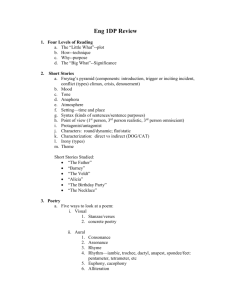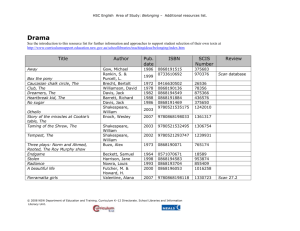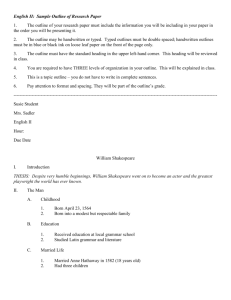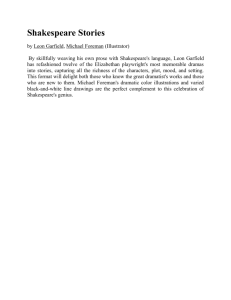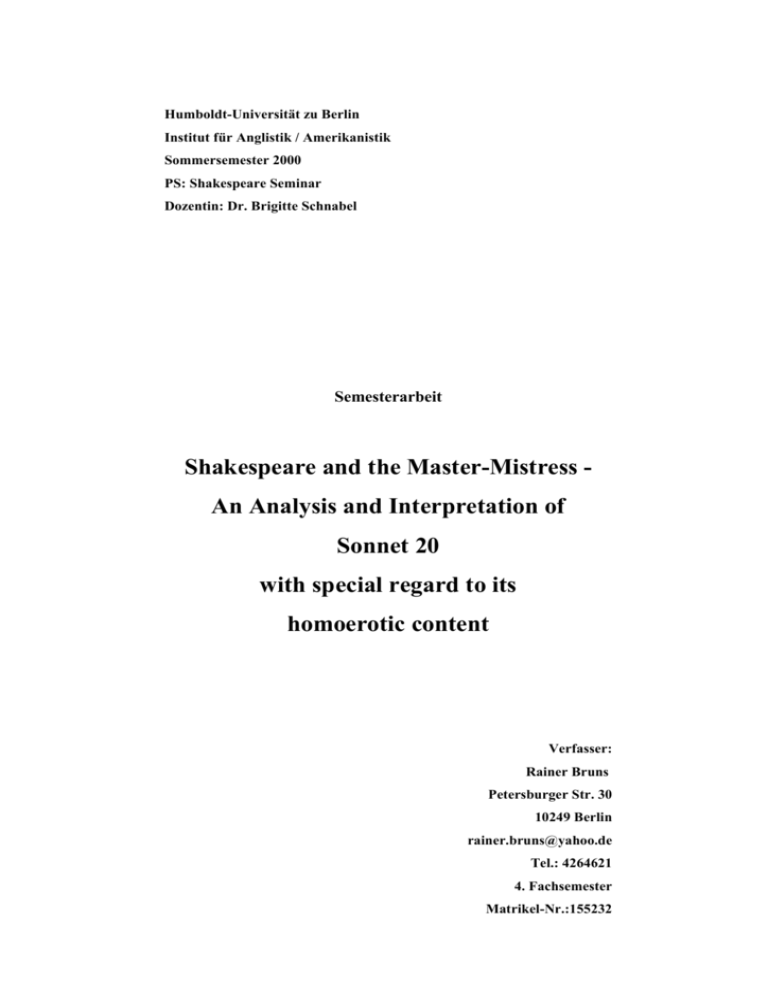
Humboldt-Universität zu Berlin
Institut für Anglistik / Amerikanistik
Sommersemester 2000
PS: Shakespeare Seminar
Dozentin: Dr. Brigitte Schnabel
Semesterarbeit
Shakespeare and the Master-Mistress An Analysis and Interpretation of
Sonnet 20
with special regard to its
homoerotic content
Verfasser:
Rainer Bruns
Petersburger Str. 30
10249 Berlin
rainer.bruns@yahoo.de
Tel.: 4264621
4. Fachsemester
Matrikel-Nr.:155232
1
Contents
Nr.
Topic
Page
Contents
1
1.
Introduction
2
2.
Analysis and interpretation of sonnet 20
3
2.1.
Form
3
2.2.
Close reading
3
2.3
Summarizing interpretation
9
3.
The biographical background - Shakespeare and
10
the young man
4.
The question of homosexuality
13
4.1.
Homosexuality in the Renaissance
13
4.2.
Publishing and reception history of the sonnets
15
5.
Bibliography
17
2
1. Introduction
The homoeroticism expressed in Shakespeare´s sonnets has been hotly
discussed for over 200 years. Shakespeare, British national hero, god of
drama, father of eight children, symbol of "high culture" - a
homosexual?
Sonnet 20 plays a central role in this debate. Some use it as evidence
proving the poets "innocence" others, however, see homosexual desires
uttered in it.
Firstly, this work will analyse and interpret sonnet 20. The "close
reading" will be accompanied by a German translation of the author of
this work. Special attention shall be paid to the ambiguities expressed
through puns or other tropes and figures.
Secondly, a look at the biographical background will be taken, notably
at the speculations about the identity of the adressee, the young man.
This will be done in order to add new aspects to the interpretation.
The last part will be about homosexuality. A dicussion about the
perception of that issue in Renaissance England will be followed by a
glance at the publishing and reception history concerning homoerotic
content.
3
2. Analysis of Sonnet 20
2.1. Form
The sonnet consists, as it is usual for Shakespearean sonnets, of three
quatrains and a couplet. Each quatrain forms a sense group of its own,
as well as the couplet, which has a concluding function.
The rhyme scheme is abab cdcd efe(‘)f(‘) gg. The rhyme in the lines 9
and 11 ("created [...] defeated") may be inexact. John Kerrigan suggests
that the words were probably pronounced "cre- ahted, def- ahted". He
also mentions that "a-doting [...] nothing" is "distinctly shaky here
(though ´th´ was harder, closer to ´d´ and ´t´, than now)". All rhymes are
feminine. The metre used is the iambic pentameter.
2.2. Close reading
The following analysis will be done line by line. You will find the
German translation of the author of this work set next to the original
line. The sense of the sonnet is often ambigious, in these cases the
translation will offer one meaning, the others will be discussed below.
A woman´s face, with Nature´s Ein Frauengesicht, von der Natur
own hand painted,
mit eigener Hand gemalt,
Supposing that the adressee is male "A woman´s face" is a metaphor.
The anthropomorphism in the second part contrasts his face with
women´s faces, which are often painted by cosmetics. Alternatively it
could also refer to Shakespeare´s protest "against the poetic praise
4
which, daubing the youth with verbal cosmetics, conceals the natural
painting of what he is, to leave him a merely ´painted beauty´". The line
ends with an enjambement.
Hast thou, the master-mistress of Hast du, Herr-Herrin
my passion;
Leidenschaft;
meiner
The alliteration "master-mistress", meaning "both man and woman",
stresses the androgynous appearance of the adressee. Stefan George
mentions that it can also have the sense of "the primary mistress",
however, as a man is adressed (because it is very unlikely that you say
"A woman´s face [...] hast thou" to a woman), this would not really
change much. In the Renaissance "mistress" did not have the meaning
of a lover of a married man but of a woman a man has fallen in love
with or is interested in. The line reveals the poetic ´I´´s homoerotic
feelings.
A woman´s gentle heart, but not Das sanfte Herz einer Frau, doch
acquainted
nicht vertraut
The repetition of "A woman´s" (line 1) is an anaphora. "Acquainted"
carries with it a pun referring to "quaint", a slang term for the female
sex organ, thus has the sense of "You are not physically a woman". The
line ends with an enjambement.
With shifting change, as is false mit der Wechselhaftigkeit, wie sie
women´s fashion;
bei den falschen Frauen üblich ist;
The pleonasm "shifting change" strengthens the sense of "change" and
puts emphasis on its durability. "False women" does not mean "that
women, who are false" but that all women are morally and - with
5
regard to the cosmetics of line one - visually deceitful. "False [...]
fashion" is an alliteration.
An eye more bright than theirs, Ein Auge, strahlender als ihre,
less false in rolling
doch weniger falsch im Schweifen
The parallelism "more bright [...] less false" again stresses the
opposition between the adressee and women in character. In addition,
"false" is a repetition from line 4, which also functions as a connection
between quatrain one and two..
Gilding the object whereupon it Das vergoldend, worauf es blickt;
gazeth;
This is a metaphor saying that everybody the adressee looks at is
enchanted. Shakespeare compares the eye of the man with the sun
casting its golden light on everything.
A man in hue all hues in his Ein Mann in der Erscheinung, der
contolling,
aller Erscheinungen fähig ist,
"A hue is a ´form´, an ´appearance´ (with strong implications of
comliness), or ´colour´ [...] [respectively] ´complexion´ " explains
Kerrigan and thereafter offers several meanings of this line: " ´a
fine-looking man, he enthrals everyone´ [...] ´though his complexion is
manly, touched by all hues it is womanly too´ [...] ´a mere man in
appearance, he controlls all living forms´,´though he looks like a man,
he has the power to adopt any form he chooses´ " On the contrary,
James Winny regards the man being "sexually neutral [...] incapable of
fulfilling either sexual role." This seems odd and inconvincing.
Eric Sams points out that in the first edition of the sonnets of 1609
(which contained many misprints) the line was printed as "A man in
6
hew all Hews in his controwling". He assumes that Hews is a kind of
name-monogram referring to Henry Wriothesley, Earl of Southampton,
while Oscar Wilde identifies the actor Willie Hews / Hughes. For
further information on this subject compare chapter 3.
Which steals men´s eyes and Betörend die Augen der Männer
women´s souls amazeth.
und die Seelen der Frauen
The structure of this line is a chiasm. "Steals men´s eyes" is a metaphor
meaning "attracting men visually". "Amazeth" here is used in the sense
of "overwhelms" or "stuns".
And for a woman wert thou first Und als Frau wurdest du zuerst
created,
erschaffen,
Kerrigan says "for a woman" here means "to be female", whereas
Bredbeck also offers " ´you were first created for sexual pleasure with
women [but now shall have it with men]´". The adress "thou" during the
sonnet implies a close relationship between the poetic ´I´ and the
adressee.
Till Natur as she wrought thee fell Bis die Natur, als sie dich bildete,
a-doting,
sich in dich vernarrte
Here again nature is personified. That not god but nature acts as creator
here reflects the Renaissance Zeitgeist, the renunciation of religion and
the middle ages accompanied by a growing interest in nature. The man´s
attractiveness is again stressed, he/she was so beautiful that even nature
went crazy.
And by addition me of thee Und durch eine Zugabe dich mir
defeated,
verwehrte,
7
The poetic ´I´ feels betrayed by nature because she deprived
("defeated") him of the perfect girl by making her/him a boy. The
internal rhyme "me [...] thee" points out that they were meant to form a
pair. "By addition" is a semantic pun, it can both have the meaning "by
honouring you" and "by adding something".
This line is the strongest counterargument against the homosexual
interpretation of the lines 9 and 12-14.
By adding one thing to my purpose Durch Zugabe eines Dinges mit
nothing.
dem ich nichts anfangen kann.
"By adding" together with the ambiguos "by addition" form an organic
paronomasia. It is quite clear that "one thing" refers to the male sex
organ."To my purpose nothing" is also ambigous. It may be read in the
sense of "of no interest to me" or "irrelevant to my concerns" as well as
"irrelevant here, in this context, this poem", which would weaken the
anti-homosexual statement of this line."Nothing" can - in opposition to
"one thing" - be read as "no thing" and thus stress the poetic ´I´´s dislike
of the man´s penis and, concluding, of homosexuality.
But since she pricked thee out for Doch da sie dich bestückte zum
women´s pleasure,
Genuß der Frauen,
"Pricked thee out" is a semantic pun. It means "select someone from a
list by pricking a paper", but it can also be used to describe "the act of
placing a young plant in a specially prepared hole". Thirdly, "prick" is a
taboo expression for penis which leads to the paraphase "she gave you a
penis". This would make much sense in connection with "women´s
pleasure" which is meant sexually. The constant repetition of the word
8
"woman / women" - it occurs six times in the sonnet - symbolizes the
femininity of the man.
Mine be thy love, and thy love´s Sei mein deine Liebe, und der
use their treasure.
Gebrauch deiner Liebe ihr Schatz.
Shakespeare uses a chiasm in connection with the semantic
paronomasia of "love" to stress the difference between the poetic ´I´´s
love for the adressee and the women´s sexual love ("love´s use"). Here
it is important that the Elisabethan sense of "love" was wider as is it in
today´s English, including things as close friendship, adoration and
deep respect (notably Germans should pay attention to this as their
"Liebe" is even more narrow in use than English "love" today). Norton
points out that " ´treasure´ and ´pleasure´ are erotic puns in Renaissance
diction, the former connoting semen, and the latter connoting orgasm or at least sexual foreplay."
Conversely, Gregory Bredbeck offers a totally different understanding
of the couplet. The old spelling of these lines was as follows:
"But since she prickt thee out for womens pleasure,
Mine be thy loue and thy loues vse their treasure."
"Loues" thus can be "love´s" as well as "loves" in the sense of "lovers"
or "desirers". Accordingly, the lines may be read " ´Since you were
created to be used as a woman (i.e. penetrated), I will be your lover, and
others (presumably women) will have to masturbate´ (´use´ of ´treasure´
playing within the metaphors of usury associated with onanism)." An
interpretation being as interesting as far fetched.
2.3. Summarizing interpretation
9
The poetic ´I´ feels a great affection for the androgynous man he talks
about. He is both attracted by his charismatic and handsome outer
appearance and his character which he compares to the character of
women in general. He considers women being false and inconstant.
Perhaps his discomfort at his homoerotic feelings makes the speaker
explain them in a heterosexual way: He points out that he is not desiring
a man but a woman who by accident got male sex characteristics. He
wants to make clear that these hinder him from wishing to have a
sexual relationship with the adressee.
His statements on this matter seem strong and vehement at first sight.
Nevertheless, the ambiguities mentioned above and somehow this
vehemence in his solemn declaration (if you read it this way) leave
much space for speculations. Does he try to persuade others, the
adressee or himself? Is he really sure about this feelings? Is he aware of
the ambiguities, or are they even intended (which would not harmonize
with line 11)? These questions can not be answered, yet this constitutes
a part of the fascination of sonnet 20.
3. The biographical background Shakespeare and the young man
For over 200 years there has been a debate among literary scholars and
historians if the sonnets reflect a part of Shakespeare´s life and "tell the
10
story of Shakespeare as a lover" or if they are to be considered fiction.
The people who think they are pure fiction are a minority.
In this part parallels between Shakespeare´s life and sonnet 20 shall be
drawn. To use this approach in order to add new aspects to the
interpretation of the poem is not unproblematical. It must be pointed out
that the author of a poem is not - or only up to a certain degree identical with the poetic ´I´.
Who was the young man?
Apart from a group of scholars assuming "Shakespeare is not analysing
the character of an actual person but exploring a complex of ideas
which his creative consciousness holds together." and others, similarly,
supposing "there must have been many men involved in the production
of that single image", there have been dozens of speculations about the
identity of the young man. Most of the literary scholars agree that the
mysterious "Mr. W. H." that is mentioned in the dedication prefixed to
the first edition of the sonnets by the editor, Thomas Thorpe, is a hint to
his identity. The dedication goes as follows:
TO. THE. ONLIE. BEGETTER. OF.
THESE. INSVING. SONNETS.
Mr. W.H. ALL. HAPPINESSE.
AND. THAT. ETERNITIE.
PROMISED.
BY.
OUR. EVER-LIVING. POET.
WISHETH
THE. WELL-WISHING.
ADVENTVRER. IN.
SETTING.
FORTH.
T.T.
11
Most of these speculations do not make much sense purely
concentrating on people Shakespeare knew that fit into these initials:
William Harte, Shakespeare´s nephew; William Hathaway, his
brother-in-law; William Hunnis, a minor poet or William Herbert, the
third Earl of Pembroke.
The two HEWS
Perhaps the most plausible candidate for the young man is Henry
Wriothesley, the third Earl of Southampton (1573-1624). Henry, like
Shakespeare, was the son of a Catholic family, in a branch related by
marriage to that of Shakespeare´s mother, the Ardens. He was known as
the patron of poets and the only known patron Shakespeare ever had.
The poems "Venus and Adonis" and "The Rape of Lucree", both
containing a remarkable account of homoeroticism, are also dedicated
to Southampton. Furthermore parallels can be drawn between the
sonnets and his biography. In the 1590, when most of the sonnets were
probably written, he refused to marry his fiancée, Lady Elisabeth de
Vere, which would fit the procreational sonnets. He was not only young
and handsome at this time, moreover his father had died in 1581,
accompanying Shakespeare writes "You had a father;" (sonnet 13, line
14). This would add new aspects to the relationship. Firstly, the class
difference, secondly, a financial supporter - supported relationship.
Moreover, it could explain the meaning of "the onlie begetter" (the man
who is both the cause and the (financial) essential of the sonnets) in the
dedication. Accordingly, there are many ambigious lines in the sonnets
that could be meant monetarily, e.g. in sonnet 29 lines 5 and 13/14.
12
"Wishing me like to one more rich in hope"; "For thy sweet love
remembered such wealth brings / That then I scorn to change my state
with kings".
As already mentioned Sams sees Wriothesley´s name hidden in the
word "Hews" of sonnet 20 and suggests that it could be read either
Henry Wriothesley Earl of Southampton or:
Henry
Wriothesley
Earl of
Southampton.
Conversely, Rictor Norton takes up an idea of Oscar Wilde. Wilde
beholds that in the sonnets there is much punning about the name
"Will" (e.g. sonnet 135) and in connection with "Hews" in sonnet 20
concludes that the adresse was the actor Willie Hughes, an androgynous
boy who used to play the women´s parts in Shakespeare´s early plays
like Juliet in "Romeo an Juliet" or Rosalynd in "As you like it"(both
written in the 1590´s). "As you like it", says Norton, is "a play whose
central theme is based upon the master-mistress metaphor and literal
transvestism. In this play Rosalynd, a girl played by a boy, dresses up in
boy´s clothing and assumes for herself the new name ´Young Master
Ganymede´" Against this background it becomes quite clear why
Shakespeare says that the adresse is "A man in hue all hues in his
contolling," in the sense of "though he looks like a man, he has the
power to adopt any form he chooses".
The Master Himself?
13
Another assumption for Mr. W.H. is "William (Shakespeare) Himself".
This is quite interesting to think about although it does not really fit into
the dedication because it is unlikely that Thorpe wished Shakespeare
"THAT. ETERNITIE. PROMISED. BY." Shakespeare, in other words,
that Shakespeare promised himself eternity.
4. The question of homosexuality
4.1. Homosexuality in the Renaissance
This issue is, to put it mildly, very complicated. In Renaissance
language the words "homosexual" and "homosexuality" simply did not
exist, for the first time it appeared in writing in 1868. Nevertheless, it
was strictly prohibited by the English law. Offenders could expect to be
sentenced to death. The term used in the law code was "sodomy" which
denoted homosexuality, pederasty and bestiality at the same time. Many
scholars have concluded from this that "homosexuality was not placed
in a special spiritual category: it was thought to stem from the same
carnal source as other sins of the fallen flesh [...][moreover] there was
no language for coping with it," Therefore a complete "absence of any
felt specicity of male homosexual desire in the culture at large" was
assumed.
By contrast, Joseph Cady convincingly argues that in the Renaissance "a
definite awareness and language for a distinct homosexuality existed, at
least among those who were willing to face and discuss the subject
frankly." Instead of "male homosexuality", he points out, the term
14
"masculine love" was used. He gives evidence analysing the use of this
term in Francis Bacon´s "New Atlantis"(1610, published 1627) and
Thomas Heywood´s "Pleasant Dialogues and Dramas"(1637), a
collection of translations from antique and contemporary European
writers, e.g the greek homosexual story of "Jupiter and Ganymede".
Anyhow, there was confusion of terms. Homosexuality was hardly
distiguished from pederasty and, as we can see in Shakespeare´s
sonnets, it is often difficult to decide whether the term "friendship" is
meant platonically or alluding to homoeroticism / homosexuality.
This may serve as one explanation why there has been a discussion
about the homoeroticism in Shakespeare´ sonnets for over 200 years.
4.2. Publishing and reception history of the sonnets
The sonnets were first published in 1609 by Thomas Thorpe. That he
did not reissue the quarto supports Lee´s assumption that it "does not
seem to have been received by the public with enthusiasm".
In 1640 John Benson rearranged the sonnets. He put them together to
longer poems, omitted eight sonnets out and changed all masculine
pronouns into feminine. The sonnets were recepted in this form until
1766, when George Steevens included an accurate transcription of the
1609 quarto in his "Twenty of the Plays of Shakespeare". However, in
15
1793 in the fourth edition of the Johnson-Steevens "The Plays of
William Shakespeare", Steevens excluded the sonnets with strong
words of condemnation: "Had Shakespeare produced no other works
than these, his name would have reached us with as little celebrity as
time has conferred on that of Thomas Watson, an older and much more
elegant sonnetteer." Three years before, in 1790, Edmond Malone
published the first serious critical edition of the sonnets. Concerning the
homoeroticism he writes that "such adresses to men, however,
indelicate, were customary in our author´s time, and neither imported
criminality, nor were esteemed indecorous". The discussion about the
nature of the relationship between Shakespeare and the young man had
begun, accompanied by discussions about the identities of the adressed
persons and the sonnet´s biographical content (Compare chapter 3).
For instance, Samuel Butler regards the sonnets as Shakespeare´s
youthful, sexual experimentation and "considering [...] the perfect sanity
of all his later work" is willing to forgive him. In 1933 Lord Alfred
Douglas "rejects the notion that Shakespeare was a homosexualist". In
addition Edward Hubler seeks "to establish the complete normality of
Shakespeare´s affective life as revealed in these sonnets". Conversely,
George Wilson Knight argues that Shakespeare was bisexual: "the
creative consciousness is bisexual; otherwise there could be no
creation". Martin Seymour-Smith thinks the sonnets describe "a
heterosexual´s homosexual experience" and "that on at least one
occasion Shakespeare did have some kind of physical relationship with
16
the Friend." Joseph Pequigney considers "the interaction between the
friends being sexual both in orientation and practice" and calls the
sonnets "the grand masterpiece of homoerotic poetry". Norton sees
evidence for this in sonnet 121:
'Tis better to be vile than vile esteemed
When not to be receives reproach of being,
And the just pleasure lost, which is so deemed,
Not by our feeling but by others' seeing.
For why should others' false adulterate eyes
Give salutation to my sportive blood?
Perhaps the wisest comment on this issue was made by Stephen Booth:
"William Shakespeare was almost certainly homosexual, bisexual, or
heterosexual. The sonnets provide no evidence on the matter"
5. Bibliography
Anspacher, Louis K.. Shakespeare as Poet and Lover and the Enigma
of the Sonnets. New York: Haskell House, 1973 (Reprint)
Bredbeck, Gregory W.. Tradition and the Individual Sodomite:
Barnfield, Shakespeare, and Subjective Desire. Journal of
Homosexuality 23 (1992): 41-68.
Cady, Joseph. "Masculine Love," Renaissance Writing, and the "New
Invention" of Homosexuality. Journal of Homosexuality 23
(1992): 9-40.
Hubler, Edward. The sense of Shakespeare's sonnets. Westport:
Greenwood Print, 1976 (Reprint of the Princeton ed..1952).
Knight, George Wilson. The mutual flame. On Shakespeare's 'Sonnets'
and 'The phoenix and the turtle'. London: Methuen, 1955.
McDaniel, John. The Eternity of Art. Shakespeare Delineated ArtistPatron Contract. Date of Access: 20 Apr. 2000. Available
http://www.nortexinfo.net/McDaniel/Shakespeare-son1.htm
Norton, Rictor. Enter Willie Hughes as Juliet or: Shakespeare´s
Sonnets Revisited. The Queer Canon, updated 9 Jan. 2000.
Available http://www.infopt.demon.co.uk/shakespe.htm
17
Pequigney, Joseph. Such is my love - a study of Shakespeare's sonnets.
Chicago: Chicago UP, 1985.
Sams, Eric. The Real Shakespeare - Retrieving the Early Years, 15641594. New Haven, London: Yale UP, 1995.
Sedwick, Eve. Comments on Karen Swann´s essay, "Harassing the
Muse". Berkshire Review 21 (1986): 104-109.
Shakespeare, William. The Sonnets and A Lover´s Complaint. 1609.
Ed. John Kerrigan. Penguin Classics. Harmondsworth:
Penguin,
1986, 1995.
Shakespeare, William. The plays and poems of W. Shakespeare. Ed.
Edmond Malone. London: Prolegomena, 1790.
Shakespeare, William; Booth, Stephen (Publisher). Shakespeare's
Sonnets. 1609. Ed. Stephen Booth. New Haven, London: Yale
UP, 1977.
Shakespeare, William; Butler, Samuel. Shakespeare's sonnets Reconsidered, and in part rearranged with introductory
chapters notes, and a reprint of the original 1609 edition. Ed.
Samuel Butler. New York: AMS Print, 1971 (Reprint of the
London edition of 1899).
Shakespeare, William; Douglas, Alfred. The true history of
Shakespeare's sonnets. London: Secker, 1933.
Shakespeare, William; George, Stefan and Günter Walch (Publisher).
Sonnets - Sonette Deutsch von Stefan George. Leipzig:
Dieterich´sche Verlagsbuchhandlung, 1989.
Shakespeare, William; Johnson, Samuel (Publisher) and Steevens,
George (Publisher). The plays of William Shakespeare with
the corrections and illustrations of various commentators. Ed.
Samuel Johnson and George Steevens. London: Longman, 1793.
Shakespeare, William; Lee, Sidney. Sonnets, with introduction and
bibliography by Sidney Lee. Oxford: Clarendon 1905.
Shakespeare, William; Seymour-Smith, Martin (Publisher).
Shakespeare's sonnets. 1609. Ed. Martin Seymour-Smith.
London: Heinemann, 1963
Shakespeare, William; Steevens, George (Publisher). Twenty of the
plays of Shakespeare. London: Tonson, 1766.
18
Winny, James. The Master-Mistress - A Study of Shakespeare´s
Sonnets. London: Chatto & Windus, 1968.

